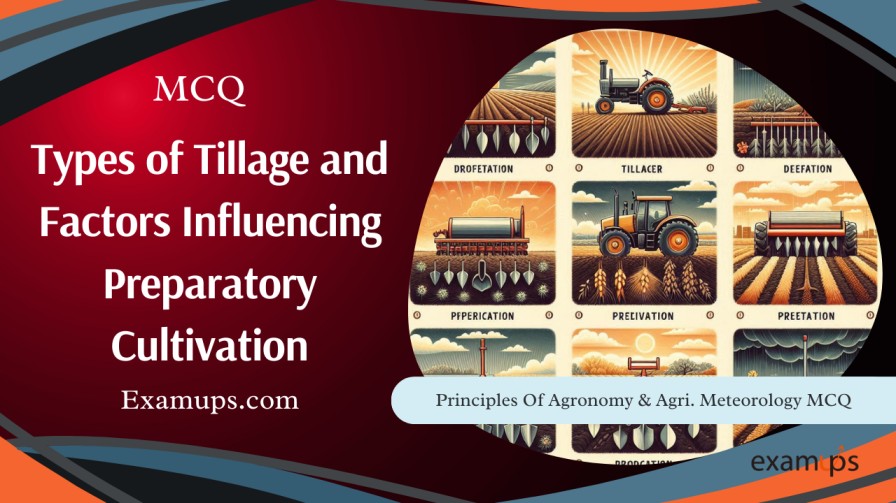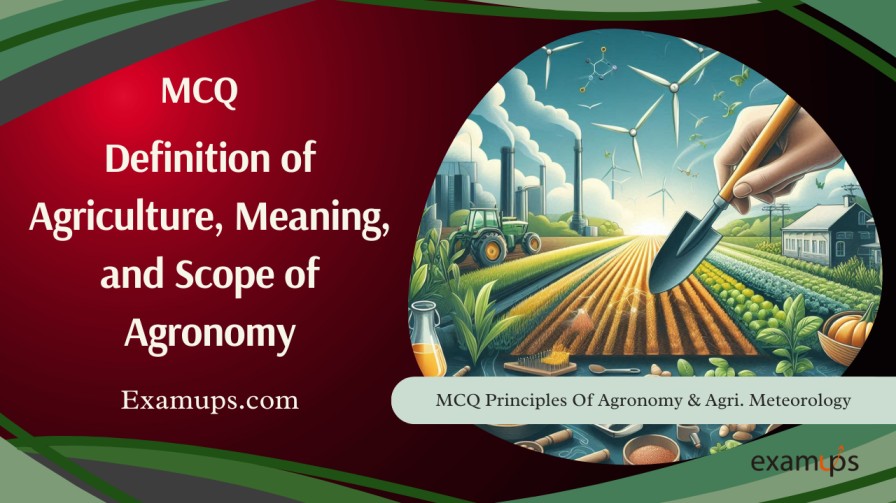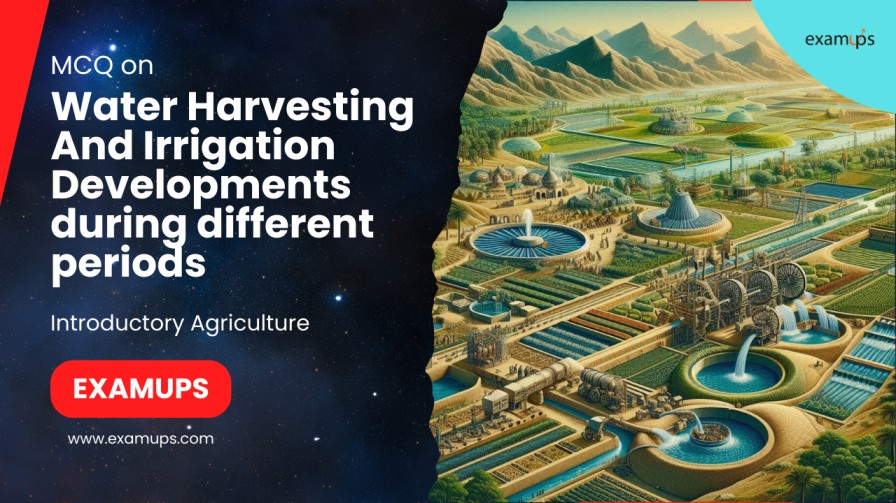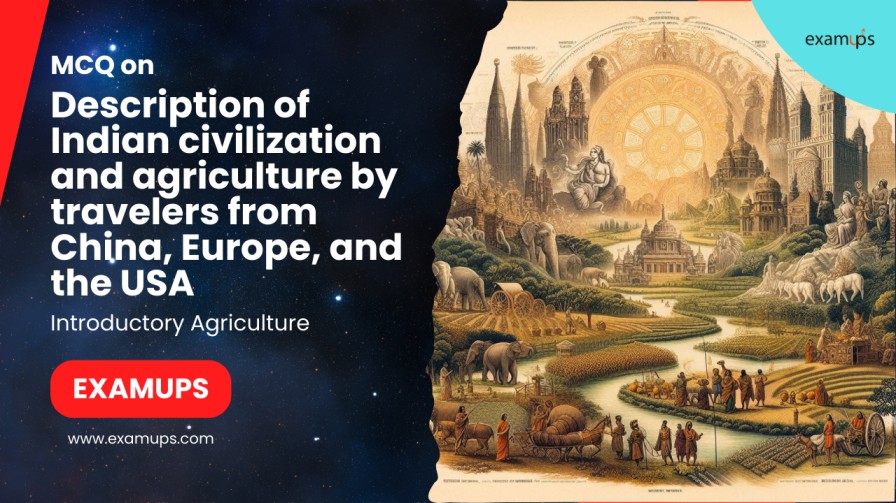Types of Tillage and Factors Influencing Preparatory Cultivation MCQ All Agriculture Exams like ICAR-JEF, ICAR-SRF, ICAR-NET, IBPS-AFO/SO, Pre-PG, BHU Pre-PG, IFFCO-AGT, CCI, FCI, B.sc, M.sc, etc.
Multiple Choice Questions on Preparatory Cultivation, After Cultivation, and Tillage Operations
- What is the main difference between preparatory cultivation and after cultivation?
a) Preparatory cultivation is done after sowing; after cultivation is done before sowing.
b) Preparatory cultivation is done before sowing; after cultivation is done after sowing.
c) Preparatory cultivation is done during crop growth; after cultivation is done before harvesting.
d) Preparatory cultivation is done only during dry seasons; after cultivation is done during wet seasons.
Answer: b) Preparatory cultivation is done before sowing; after cultivation is done after sowing.
Explanation: Preparatory cultivation involves tillage operations before sowing, whereas after cultivation is carried out after the crop has been sown. - Which tillage operation is generally classified as primary tillage?
a) Ploughing
b) Harrowing
c) Seedbed preparation
d) Intercultivation
Answer: a) Ploughing
Explanation: Primary tillage generally involves ploughing, which is the initial breaking of soil to prepare it for sowing or planting. - What tillage operation is typically classified as secondary tillage?
a) Ploughing
b) Harrowing
c) Seedbed preparation
d) Intercultivation
Answer: b) Harrowing
Explanation: Harrowing is a secondary tillage operation used to refine the soil after ploughing, to break up larger clods, and to level the field. - Which crop may require deep tillage due to its deep-rooted stubble?
a) Cotton
b) Rice
c) Wheat
d) Maize
Answer: a) Cotton
Explanation: Cotton has deep-rooted stubble, which necessitates deeper tillage to ensure the stubble is removed and the soil is adequately loosened. - What type of tilth is required for crops like tobacco and chilies?
a) Rough tilth
b) Fine tilth
c) Coarse tilth
d) Medium tilth
Answer: b) Fine tilth
Explanation: Crops like tobacco and chilies require fine tilth for proper seedbed preparation due to their smaller seed size and sensitivity to soil structure. - How does soil type affect preparatory cultivation in clay soils?
a) Clay soils require a narrow range of soil moisture for tillage.
b) Clay soils require deep tillage for better structure.
c) Clay soils require intensive harrowing after ploughing.
d) Clay soils require reduced tillage to avoid compaction.
Answer: a) Clay soils require a narrow range of soil moisture for tillage.
Explanation: Clay soils can be ploughed only within a narrow range of soil moisture; ploughing when too wet can lead to compaction, and when too dry, it becomes difficult. - Why is deep tillage generally not recommended in shallow soils in low-rainfall areas?
a) Leads to rapid drying and loss of stored soil moisture.
b) Causes soil compaction.
c) Results in increased erosion.
d) Requires excessive energy.
Answer: a) Leads to rapid drying and loss of stored soil moisture.
Explanation: Deep tillage in shallow soils with low rainfall can lead to rapid drying and loss of moisture, which could be detrimental to the growth of crops. - What is the primary goal of intercultivation?
a) Destroying weeds
b) Preparing the seedbed
c) Reducing soil erosion
d) Enhancing soil fertility
Answer: a) Destroying weeds
Explanation: Intercultivation is a tillage operation done between crop rows primarily to control weeds and also to form soil mulch, prevent soil cracking, and crust formation. - Which factor is most likely to influence the type of preparatory tillage used?
a) Soil texture
b) Soil structure
c) Soil moisture
d) Crop type
Answer: d) Crop type
Explanation: The type of preparatory tillage used is significantly influenced by the crop type, which determines the depth and intensity of tillage based on root systems and the need for different levels of soil refinement. - What is puddling, and when is it used?
a) The process of reducing soil moisture content; used in dry land farming.
b) The process of creating a waterlogged soil condition; used in rice cultivation.
c) The process of incorporating organic matter into soil; used in organic farming.
d) The process of leveling soil; used in field preparation.
Answer: b) The process of creating a waterlogged soil condition; used in rice cultivation.
Explanation: Puddling involves creating a waterlogged condition by breaking down soil aggregates to form a compact layer, often used in rice cultivation to minimize water loss and suppress weed growth.
Multiple Choice Questions on Intercultivation and Puddling
- When does intercultivation typically start for short-duration crops?
a) 2-3 weeks from sowing
b) 3-4 weeks from sowing
c) 5-6 weeks from sowing
d) Immediately after sowing
Answer: a) 2-3 weeks from sowing
Explanation: Intercultivation for short-duration crops usually starts 2-3 weeks from sowing to control weeds, improve soil aeration, and break up soil crusts. - What is the purpose of rogueing in crops grown for seed production?
a) To control weeds
b) To remove undesirable or diseased plants
c) To improve soil aeration
d) To ensure uniform crop growth
Answer: b) To remove undesirable or diseased plants
Explanation: Rogueing involves removing off-type or diseased plants from a crop grown for seed production to maintain purity and quality of the seed. - Which after-cultivation operation involves building up soil around the base of plants like sugarcane, banana, and groundnut?
a) Earthing up
b) Thinning
c) Nipping
d) Propping
Answer: a) Earthing up
Explanation: Earthing up involves heaping soil around the base of plants to provide support, promote root development, and reduce lodging. - What is the goal of desuckering in banana cultivation?
a) To remove side shoots
b) To improve soil aeration
c) To increase fruit size
d) To control weed growth
Answer: a) To remove side shoots
Explanation: Desuckering involves removing unwanted side shoots (suckers) from banana plants to focus the plant’s energy on the main stem, enhancing fruit production. - Which after-cultivation operation is used to prevent sugarcane from lodging and ensure upright growth?
a) Propping
b) Topping
c) Earthing up
d) Trimming
Answer: a) Propping
Explanation: Propping involves using sticks or other supports to keep sugarcane stalks upright, preventing them from bending or lodging due to wind or weight.
Multiple Choice Questions on Puddling and Related Concepts
- What is the primary objective of puddling in rice cultivation?
a) To create an impervious layer to reduce water percolation
b) To incorporate organic matter into the soil
c) To improve soil structure
d) To control weeds
Answer: a) To create an impervious layer to reduce water percolation
Explanation: Puddling creates an impervious layer below the soil surface to minimize deep water percolation, allowing rice to grow in submerged conditions. - What is the purpose of planking or using a leveling board during puddling?
a) To level the field
b) To break soil clods
c) To incorporate organic matter
d) To remove large rocks and debris
Answer: a) To level the field
Explanation: Planking or using a leveling board is done to ensure the field is level, facilitating uniform water distribution during rice cultivation. - How can you test if puddling has been done thoroughly?
a) By checking if mud flows freely through fingers
b) By measuring soil moisture content
c) By assessing soil color
d) By evaluating soil temperature
Answer: a) By checking if mud flows freely through fingers
Explanation: A simple test for thorough puddling is to take a handful of mud and press it. If it flows freely through fingers without hard lumps, the puddling is considered thorough. - Which tillage operation aims to destroy soil structure intentionally?
a) Puddling
b) Ploughing
c) Harrowing
d) Intercultivation
Answer: a) Puddling
Explanation: Unlike other tillage operations, puddling aims to destroy soil structure, breaking down soil aggregates to create a mud-like consistency necessary for rice cultivation. - Why is puddling done in both directions during the final ploughing?
a) To ensure even soil mixing and leveling
b) To reduce soil compaction
c) To increase soil moisture retention
d) To remove weeds more effectively
Answer: a) To ensure even soil mixing and leveling
Explanation: Puddling in both directions during the final ploughing ensures even mixing of soil and proper leveling, creating a consistent and uniform seedbed for rice.
Multiple Choice Questions on Puddling and Related Concepts
- What is a key characteristic of the impervious layer formed during puddling?
a) It is created by compacted soil particles.
b) It has high permeability.
c) It allows deep percolation of water.
d) It contains large pores that facilitate drainage.
Answer: a) It is created by compacted soil particles.
Explanation: The impervious layer formed during puddling is created by compacted soil particles, resulting in reduced water percolation and increased water retention. - What is the sequence of particle settling during puddling?
a) Sand, silt, clay
b) Clay, silt, sand
c) Silt, sand, clay
d) Sand, clay, silt
Answer: a) Sand, silt, clay
Explanation: During puddling, heavier sand particles settle first, followed by silt, with the lighter clay particles settling last. This sequence contributes to the formation of the impervious layer. - Why is puddling difficult in soils with a bulk density less than 1.0?
a) The soil becomes too loose, causing equipment to sink.
b) The soil is too hard to plough.
c) The soil contains too much organic matter.
d) The soil has high water retention, causing flooding.
Answer: a) The soil becomes too loose, causing equipment to sink.
Explanation: Soils with a bulk density less than 1.0 tend to be loose, making it difficult for animal-drawn implements to operate without sinking deeply, which complicates puddling. - Which implement is most likely to be used for puddling in smaller farms?
a) Wetland plough
b) Tractor-drawn plough
c) Green manure trampler
d) Spade
Answer: a) Wetland plough
Explanation: Wetland ploughs are commonly used for puddling on smaller farms due to their effectiveness in churning the soil quickly and efficiently. - What is the primary advantage of using a wetland puddler over a country plough for puddling?
a) The puddling operation is completed more quickly.
b) It requires less water.
c) It is easier to maintain.
d) It produces a finer tilth.
Answer: a) The puddling operation is completed more quickly.
Explanation: The wetland puddler is designed to complete the puddling operation quickly due to its series of blades that churn the soil effectively, reducing the time required for thorough puddling. - Why are cage wheels used on tractor-drawn implements for puddling?
a) To prevent the tractor from sinking in the mud.
b) To increase traction on slippery surfaces.
c) To provide additional support for heavy loads.
d) To improve maneuverability in wet fields.
Answer: a) To prevent the tractor from sinking in the mud.
Explanation: Cage wheels are used on tractor-drawn implements to provide additional support and prevent the tractor from sinking during puddling, enabling the use of heavier machinery in wet fields. - What is the purpose of incorporating green manure in rice fields during puddling?
a) To add organic matter and nutrients to the soil.
b) To reduce soil erosion.
c) To improve soil structure.
d) To increase soil aeration.
Answer: a) To add organic matter and nutrients to the soil.
Explanation: Green manure is incorporated into rice fields during puddling to add organic matter and nutrients, which enhances soil fertility and promotes better rice growth. - Which of the following is NOT typically used as a puddling implement?
a) Country plough
b) Green manure trampler
c) Mouldboard plough
d) Harrow
Answer: d) Harrow
Explanation: Harrows are generally used for secondary tillage operations, such as breaking up clods after ploughing. Puddling requires implements designed to churn and compact soil, which harrows do not typically do. - Why is it essential to maintain standing water during puddling?
a) To create the desired impervious layer and soften the soil.
b) To reduce weed growth.
c) To prevent soil erosion.
d) To facilitate soil aeration.
Answer: a) To create the desired impervious layer and soften the soil.
Explanation: Maintaining standing water during puddling is crucial for creating an impervious layer and softening the soil, which is necessary for effective rice cultivation. - Which factor does NOT influence the effectiveness of puddling?
a) Soil moisture content
b) Depth of water applied
c) Soil temperature
d) Direction of ploughing
Answer: c) Soil temperature
Explanation: While soil moisture, the depth of water applied, and the direction of ploughing are important factors in puddling, soil temperature does not significantly influence the effectiveness of puddling in rice cultivation.











